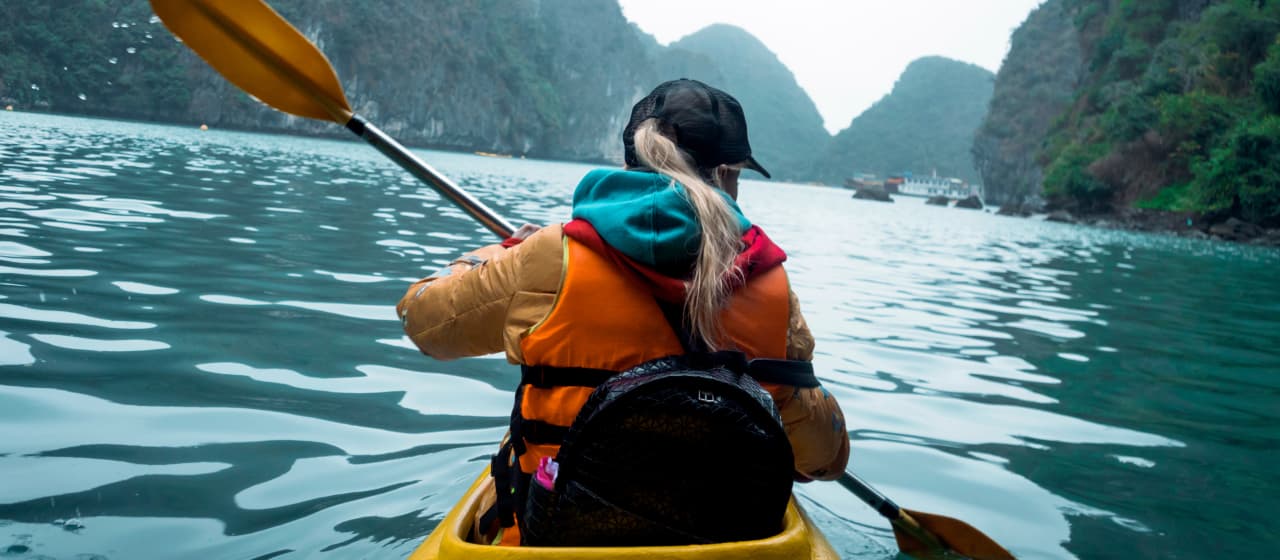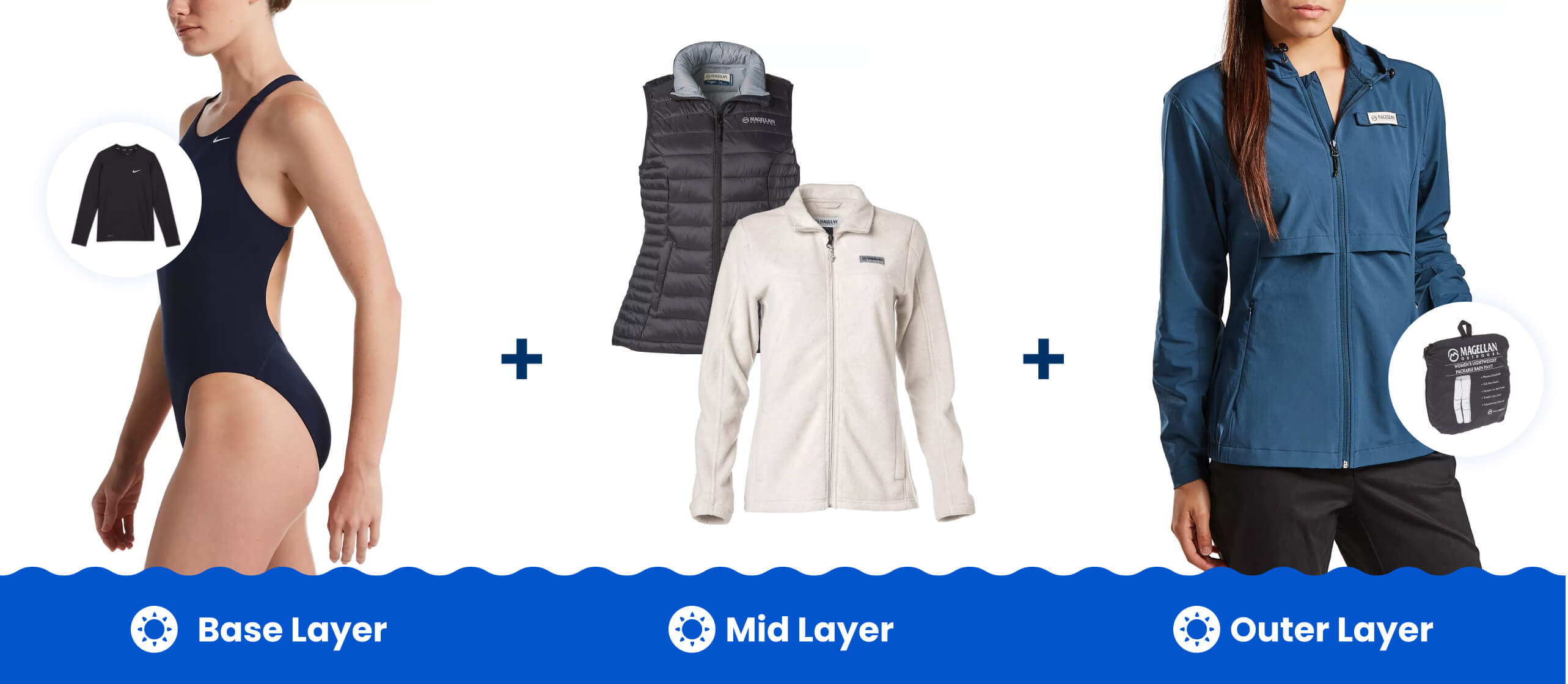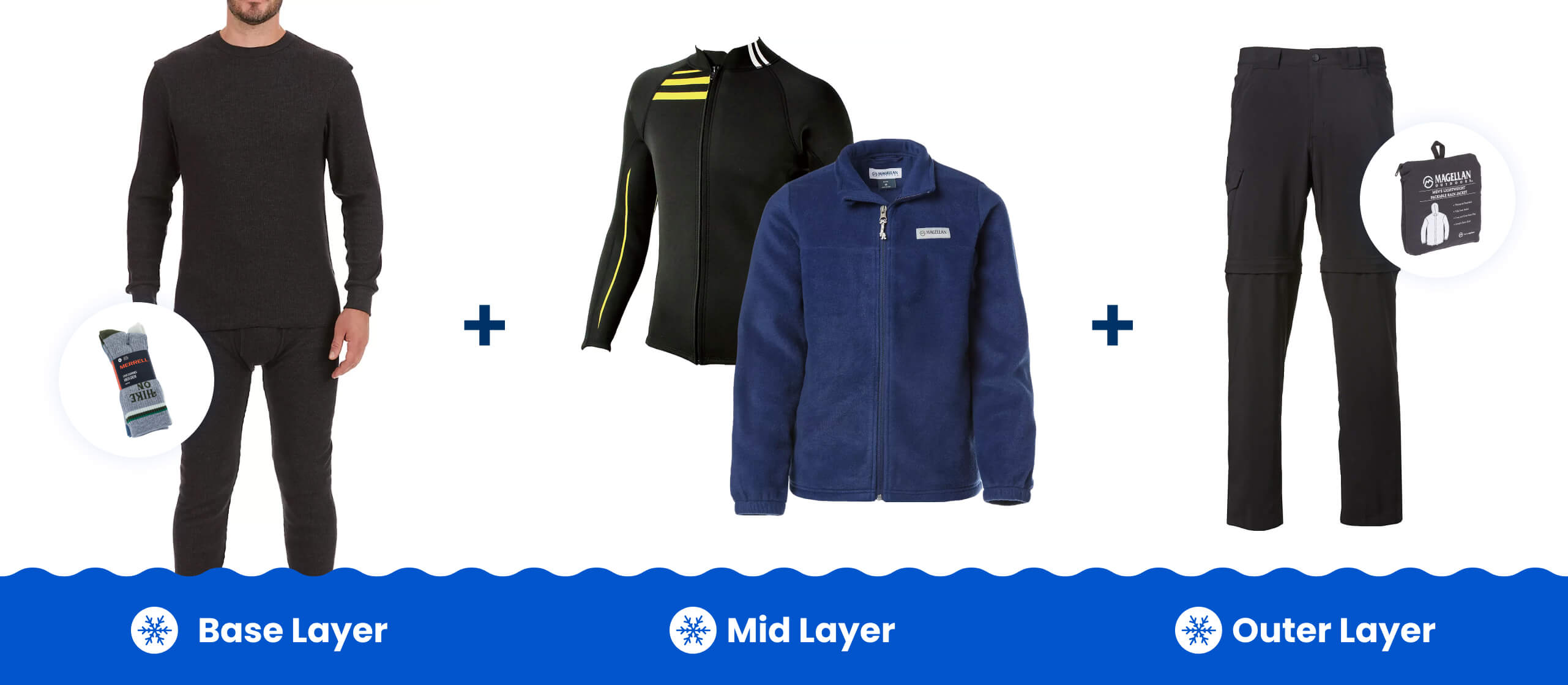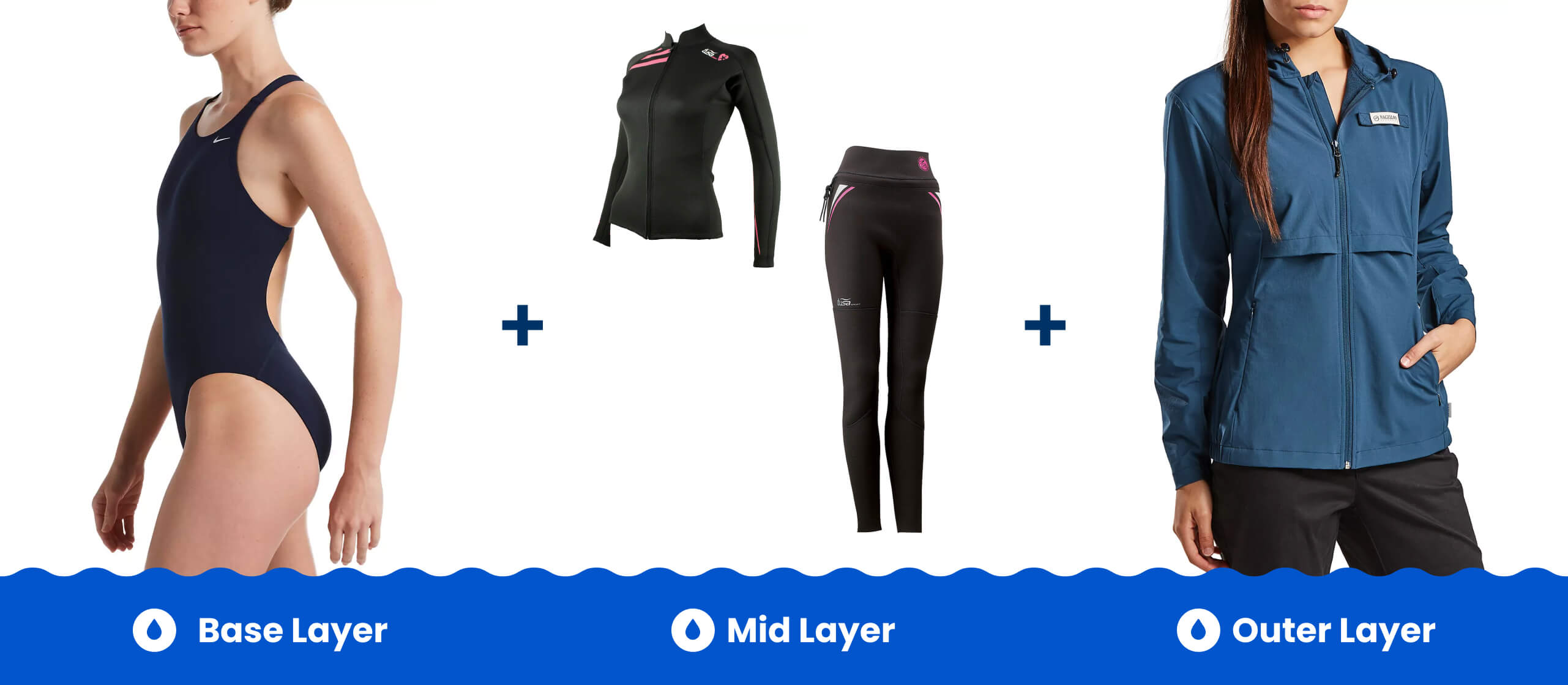Kayaking Outfit Guide: Stay Dry, Safe & Comfortable on the Water

No matter where you choose to paddle your kayak — be it on a recreational lake in the height of summer or along the coast in the dead of winter — knowing what to wear kayaking is crucial. Luckily, you don’t have to spend a small fortune to have a great time on the water. Let’s dive into the essential gear you need to wear when flatwater kayaking to prepare you for your next adventure!
Key Takeaways
- What to Wear Kayaking: Layering Tips — No matter the season or water temperature, you should always wear layers when kayaking. Always base your layers on the water temperature.
- What to Wear When Kayaking by Water Condition — Learn what layers, fabrics, and types of clothing to wear when kayaking in warm and cold water.
- What Shoes to Wear Kayaking — Wear neoprene paddling booties, water shoes, or water sandals. Don’t wear anything without a backstrap, and don’t kayak barefoot.
- Other Essential Gear to Wear Kayaking — Other gear you should wear kayaking include paddling gloves, wide-brimmed hats, and life jackets.
- What Not to Wear Kayaking — Never wear cotton, metal, flip-flops, or too many layers. You should also avoid keeping your phone in your pocket.
What to Wear Kayaking: Layering Tips
When kayaking, you should always wear layers of clothing to help you stay comfortable in any weather condition — even in the summer. There’s a huge likelihood that you’ll end up submerged in the water, so stick to thinner layers that are both adaptive and well-insulated. Those thin layers can also give you the best mobility as you maneuver atop the water.
Tip 1: Layer for the Water — Not the Weather
Even if the surface temperature is relatively warm, the water may not be. Your clothes can protect your internal temperature should your kayak capsize. When the water is cold enough, hypothermia becomes less of a hypothetical risk and more of a potential threat.
Before you head out, know the water’s temperature so you can prepare accordingly. Wet and dry suits are great layering options for regulating your body temperature in water.
Tip 2: Never Wear Cotton
Out of all the fabrics out there for you to wear, cotton is usually the worst choice for cold and wet conditions because it absorbs water and retains moisture. If your kayak capsizes, cotton clothes can become heavy and weigh you down. Instead, go for moisture-wicking and quick-drying materials.
Expert Tip:
Nylon and polyester are widely available materials that are great for kayaking because they don’t absorb water.
Tip 3: Never Forego Your Life Jacket
Arguably, the most important piece of equipment every kayaker should wear is a life vest — often called a life jacket or even a personal flotation device. Every person in or on the water should always wear one of these, even if they know how to swim. This will protect you if your kayak capsizes and you are stranded or incapacitated.
Always Wear Sun Protection
Regardless of the temperature outside or the amount of clouds in the sky, the sun’s UV rays can still harm you. Always wear hats, sunscreen, UPF-rated clothes, and sunglasses to protect your eyes and skin.
Wear Comfortable, Abrasion-Resistant Clothes
Paddling a kayak requires a lot of movement and sitting for extended periods. Choose comfortable yet rugged clothes to withstand wear and tear caused by sand, water, and equipment. Make sure the clothes fit well so they won’t interfere with paddling.
What to Wear When Kayaking by Water Condition
When kayaking, always dress for the water rather than the weather. The main benefit of a good layering strategy is that you’ll be able to explore more when you’re out on the water while staying protected from the elements — no matter the season. We’ve put together recommendations on what to wear for kayaking based on the water conditions below.
What to Wear Kayaking in Warm Water

No matter if it’s your first time or if you’re looking to upgrade from a bathing suit to gear that makes longer trips more comfortable, here’s what we recommend wearing when kayaking in warm water:
Base Layer
-
Swimsuit: A great option when kayaking for less than a couple of hours in warm water.
-
Underwear: For longer trips, wear a sports bra and underwear made of synthetic, moisture-wicking fabrics.
-
Top: Wear rash guards and swim shirts or a non-cotton shirt.
-
Bottom: Boardshorts are another great option. Avoid thinner fabrics since you'll need to maneuver around in your seat.
Mid Layer
-
Synthetic Long-Sleeve Top: Consider wearing a UPF-protecting long-sleeve shirt over your base layers.
-
Fleece Jacket: Wear a fleece jacket if it's cold.
-
Fleece Vest: Wear a fleece vest for extra warmth when it isn't as cold out.
Outer Layer
-
Windbreaker: Wear a windbreaker on windy days
-
Rain Jacket & Pants: Bring a lightweight Rain jackets and rain pants if the forecast calls for rain.
-
Water or Boat Shoes: In milder water conditions, water and/or boat shoes can be a fantastic option.
What to Wear Kayaking in Cool-to-Cold Water Conditions

There are unique potential risks when you kayak in water cooler than 70 degrees Fahrenheit should your kayak capsize. This guide focuses on milder, cooler conditions as opposed to the more polar conditions you’d find on a touring expedition in the height of winter. In cool conditions, we recommend the following layers:
Mid Layer
-
Fleece Jacket or Vest: Wear a fleece jacket or vest in cooler water conditions.
-
Wetsuit: wetsuit shirts and pants will help you stay warm in cold water by using your body heat.
-
Boots or Shoes: Wading boots and deck boots can be a good choice for colder months or rainy days.
Outer Layer
-
Bottom: If you don’t feel you need a wetsuit, polyester pants are a great alternative!
-
Rain Jacket & Pants: Wear lightweight rain jackets and rain pants to stay dry on cool, rainy days.
How to Layer With a Wetsuit

As you paddle through the water, it can (and will) splash you. Wearing a wetsuit will help you stay warm despite this. You can wear them in warm water conditions, but they’re especially important for cold water conditions. Here are some considerations for layering with a wetsuit:
- Base Layer: If you want the convenience of changing out of your wetsuit when you’re done kayaking, wear a bathing suit underneath to change quickly and easily. Otherwise, wear fast-drying underwear.
- Mid Layer: Depending on where you plan to kayak, most standard wetsuits will suffice for cooler flatwater locations. If there’s a bit more of a freezing bite to the water temperature, choose a thicker wetsuit!
- Outer Layer: Windbreakers are the perfect outer layer when you’re wearing a drenched wetsuit. They help block any wind as you paddle through the water.
Expert Tip:
Wetsuits are made of a rubber called neoprene. They warm you up by locking in a layer of water and your body heat. You’ll be wet, but you won’t be freezing!
What Shoes to Wear Kayaking
While it may be tempting to kayak barefoot on a warm summer day, it’s not safe, and you could lose the shoes you brought with you. Instead, opt for neoprene paddling booties, water shoes, or water sandals. Don't wear anything without a backstrap because they fall off easily. If you’re kayaking in cold water, paddling booties are your best option for staying warm.
Other Essential Gear to Wear Kayaking
- Gloves: Paddling gloves can protect your hands from cold weather and blisters when kayaking for longer distances.
- Wide-brimmed Hat: Donning a hat with a wide brim or even capes helps protect your head from sun exposure. Choose one with a chin strap to keep it from floating away with the first wind gust.
- Personal Floatation Device (PFD): Life vests are non-negotiable for all kayakers — even if you’re paddling through a shallow flatwater lake! Choose a paddling life vest to avoid movement restrictions.
Expert Tip:
When kayaking in colder water, consider equipping your kayak with a spray skirt to minimize water splashing.
What Not to Wear kayaking
- Avoid cotton in any layer. It absorbs water, stays wet, and can weigh you down when soaked.
- Avoid wearing too many layers. They tend to fall off when you paddle, and you’ll likely lose track of them in the water if you capsize.
- Don’t put your phone in your pocket. If you bring yours, slide it into a waterproof, floating phone case to ensure it’s protected should you capsize.
- Don’t wear metal zippers. They corrode quickly in water. Look for velcro or plastic zippers instead.
- Avoid flip-flops & loose shoes. They’re easy to slip in and tend to fall off when you paddle. Anytime you’re submerged, you’ll likely lose track of them in the water.
Have Fun Out There!
Now that you know what to wear kayaking, you’re all set to hit the water in comfort and style! Just remember to dress in layers, pick materials that dry quickly, and always wear your life jacket. Stay safe, have fun, and enjoy your adventure!


